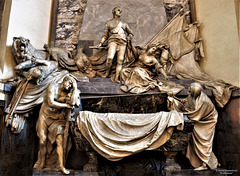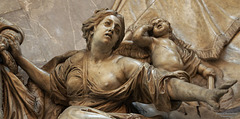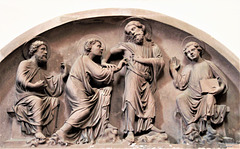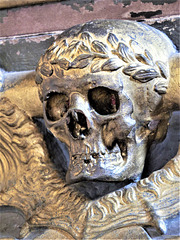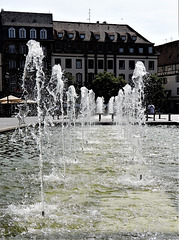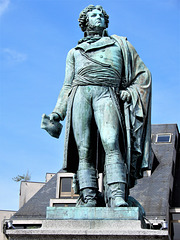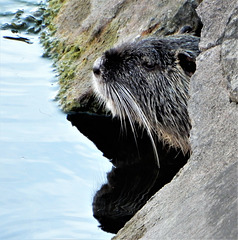
Strasbourg
Stroll through Strasbourg 2xPiP
| |
|
|
|
The church is known for its historically / musically important organs:
A Silbermann organ from 1741, on which Wolfgang Amadeus Mozart played in 1778, was restored in 1979 to approximate the original. The Silbermann organ has 38 stops on three manuals and pedal.
PiP 1: Original console of the Silbermann organ
PiP 2: The choir organ built in 1905 according to plans by Albert Schweitzer and installed in 1906.
Stroll through Strasbourg
| |
|
|
|
Inside the church there are several funerary monuments from the period 1130 to 1850, one of the most famous being the huge late baroque mausoleum from 1777 of Marshal Hermann Moritz of Saxony, a work of the Parisian sculptor Pigalle. Since the marshal was of Lutheran faith, he was not allowed to be buried in the French capital.
The marshal walks down the stairs to the coffin, which death opens. France tries to hold him back and Hercules mourns. The heraldic animals on the left represent the empires of Austria/ the eagle, Holland/ the lion and England the leopard.
Moritz of Saxony already enjoyed great popularity during his lifetime, among his soldiers for his humanity and fairness, among the people for his victories - he was one of the few undefeated commanders of France, which made him a myth in his day.
Stroll through Strasbourg 2xPiP
| |
|
|
|
She wanted to hold back Moritz of Saxony as he descended the stairs to death
PiP 1: Death who opens the lid of the coffin, in his hand the time runs out
PiP2: Hercules no longer understands the world and mourns
Stroll through Strasbourg 1xPiP
| |
|
|
|
Thomas Church
Every year many visitors from all over the world come to discover the building, the history of the West, the centuries-old past, from the Romanesque to the Gothic.
Already in the 7th century Irish monks built the first wooden church on this site and founded a monastery. The connection to Saint Thomas is not limited to what we can see today.
Stroll through Strasbourg
| |
|
|
|
The skull, a figurative, graphic and sculptural symbol in Western culture, representing a human skull.
The skull serves to symbolize or threaten physical danger and death, the transience of human life and earthly works and goods.
Stroll through Strasbourg Kléberplatz
| |
|
|
|
The Kléberplatz is one of the central squares in Strasbourg.
Originally it was called Barfüßerplatz in reference to the neighbouring Franciscan monastery, in the 17th century it was renamed Waffenplatz and since 1840 known as Kléberplatz the name of General Jean-Baptiste Kléber who came from Strasbourg.
The square is used for large rallies and the Christkindelsmärik (Christmas market), it plays a central role for the people of Strasbourg and the entire urban area.
The Christmas Market on 11 December 2018 was the scene of an Islamist attack that killed five people and injured thirteen. The perpetrator was shot dead by a special police unit on 13 December 2018 after fleeing for 48 hours.
The square is bordered to the north (left side in the photo) by the Hauptwache, which was built in the neoclassical style of the 18th century. In the building there is a part called the Sistine Chapel of Contemporary Art, designed by the artists Theo van Doesburg, Jean Arp and Sophie Taeuber-Arp.
Stroll through Strasbourg Kléberplatz
| |
|
|
|
These water games are a great attraction especially in summer, the children love to play in them
Stroll through Strasbourg Kléberplatz
| |
|
|
|
On 24 June 1840, the monument in the middle of the square was inaugurated by General Jean-Baptiste Kléber. Standing upright, he holds in his hand the letter in which British Admiral Keith had unsuccessfully asked him to surrender the French troops in 1800. Below the sculpture is the crypt where the coffin Kléber was buried in 1838, two years before the monument was consecrated.
Stroll through Strasbourg Place de l'Homme de Fer
| |
|
|
|
The Mysterious Iron Man
It is the year 1740 at number 2 of Place de l'Homme de Fer, which is inhabited by a harquebusier (sniper) named François Hilbert. For his shop ,an armoury, he decides to put a life-size statue of Knight in armour from the end of the 16th century as an advertising sign.
This was probably a real marketing coup for this shop owner at the time, because the statue has been standing there for all these years now. Few of today's major brands can boast a logo or sign as old as that of this small shopkeeper.
The current statue is a copy, but the original can still be seen in the Historical Museum of Strasbourg.
Stroll through Strasbourg 1x PiP
| |
|
|
|
Here a cheeky inhabitant from Strasbourg
The nutria, also called beaver rat, a rodent species originating from South America and naturalized in Central Europe.
Nutrias are sometimes confused with the muskrat, which originates from North America, but is smaller.
Nutrias have a body length of up to 65 cm and weigh between eight and ten kilograms, so they are smaller than a beaver. As with many animal species, male Nutrias are generally slightly larger than the females. On their hind feet they have webbed feet, very conspicuous in adult animals is the orange coloration of the rodent teeth, which is caused by iron deposition.
The original home of the Nutria living at rivers, lakes, ponds and in swamps is the subtropical and moderate South America.
Today, Nutrias are considered naturalized in large parts of North America and Eurasia.
With these not really popular city dwellers our Strasbourg walk comes to an end, nice that you are with me.
Jump to top
RSS feed- Latest items - Subscribe to the latest items added to this album
- ipernity © 2007-2024
- Help & Contact
|
Club news
|
About ipernity
|
History |
ipernity Club & Prices |
Guide of good conduct
Donate | Group guidelines | Privacy policy | Terms of use | Statutes | In memoria -
Facebook
Twitter


